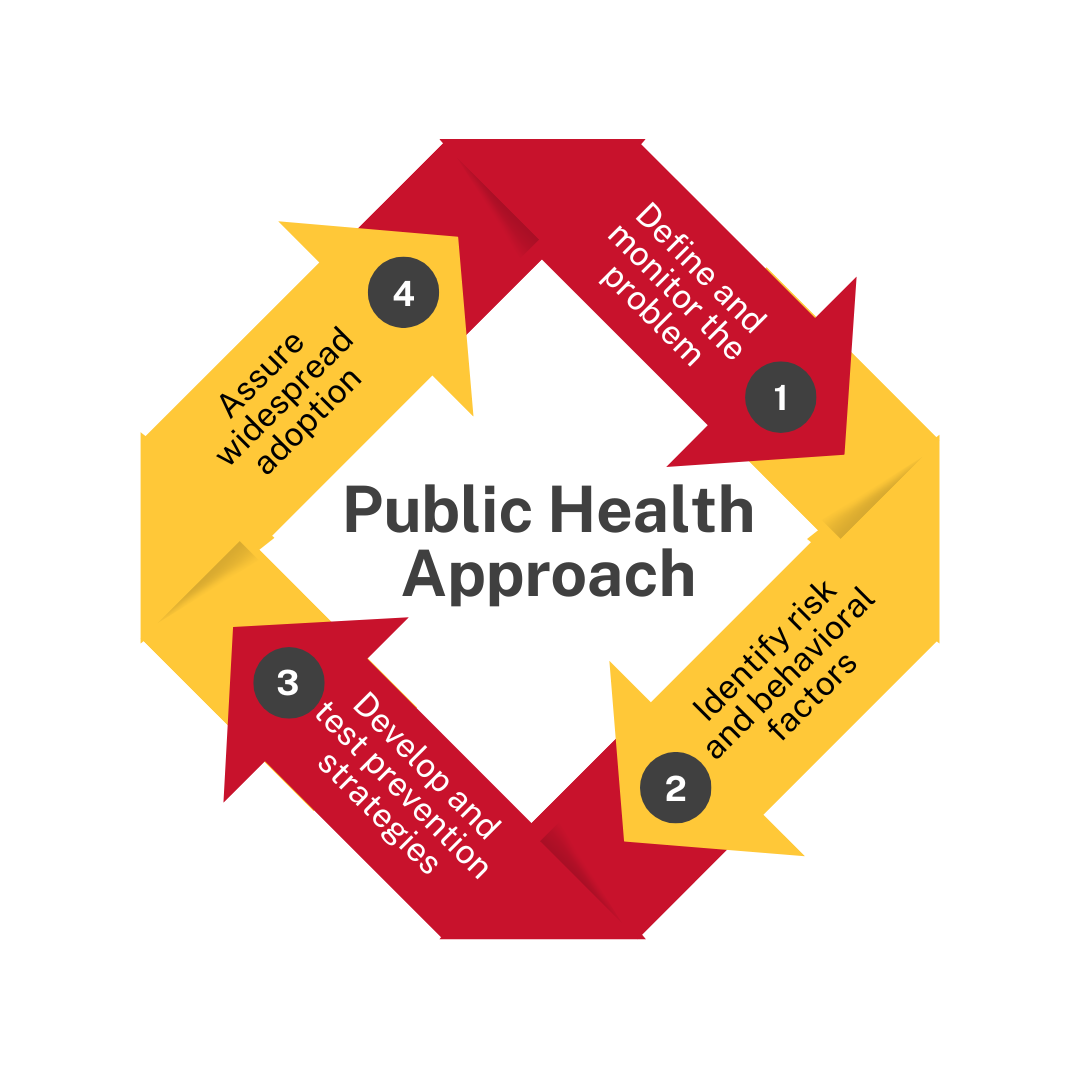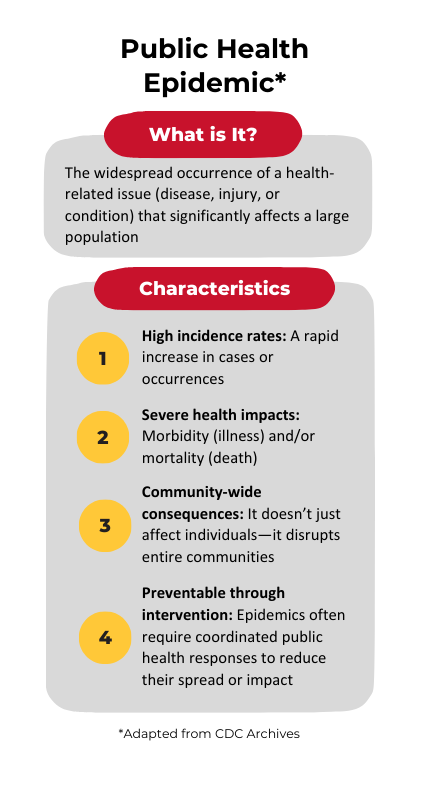What is Public Health?
Public health aims to prevent illness and injury and support the well-being of people, families, and communities. Public health activities focus on improving health within communities that need it most. Data can help public health professionals identify areas of need, track trends over time, and measure change. Examples of public health activities can include research, health education, services to improve individual or community health, or policy change. The CDC identified 10 essential public health services, which are available here.
What is the Public Health Approach?
 The public health approach is broken down into four steps:
The public health approach is broken down into four steps:
1. Define and Monitor the Problem: The first step is identifying the health issue, studying its scale, and tracking how it changes over time.
2. Identify Risk and Protective Factors: The second step is to determine what can worsen the health or safety problem or put the person at risk (risk factors) and what can help prevent it (protective factors).
3. Develop and Test Prevention Strategies: Next, programs and policies are developed to reduce the problem or stop its spread. These interventions are tested to see if and how they work.
4. Assure Widespread Adoption: The last step is to share successful solutions and expand where and with whom they are used. New programs and policies can be adapted to increase relevance in different contexts and communities.
The public health approach embraces quality improvement, so this process is continual and programs can policies can improve and change over time. Learn more about using the CDC's public health approach for violence prevention here.
How can the Public Health Approach be Used to Address Gun Violence?
Gun violence is a leading cause of death, such as cancer or heart disease. Applying the public health approach in Maryland is essential to reduce and prevent firearm violence.
- Define and monitor the problem: Data is used to identify communities, neighborhoods, and individuals most at risk for experiencing violence. The Firearm Violence Data Dashboard includes several public health data sources that show the extent of firearm violence in Maryland, including homicide and suicide, as well as firearm injuries treated in hospitals.
- Identify risk and protective factors: Certain factors may protect and buffer communities against violence, while exposure to other factors may increase risk. Risk factors for gun violence include, but are not limited to, weak policies and laws that allow easy access to firearms, systemic poverty, lack of employment opportunities, and alcohol misuse or outlet density. Some groups are exposed to more risk factors than others due to unequal community conditions and environments. Gun violence can be reduced by changing risk and protective factors. The Center educates policymakers and state leaders on the risk and protective factors experienced by Marylanders to help inform effective policy.
- Develop prevention strategies: Research and practice identify evidence-informed policies and programs to reduce firearm violence. In Maryland, these policies and programs are carried out by organizations and agencies in various sectors, such as non-profit, criminal justice, and health settings. The Center supports, funds, and promotes prevention strategies based on the Three Pillars.
- Conduct research and evaluation and scale up what works: Public health experts identify what saves lives to scale and expand the work by collecting and analyzing data on firearm violence prevention policies and programs. The Center serves as a convener to share what works with community leaders to inform future plans in areas impacted by gun violence.
Public health can provide proven and promising strategies to prevent gun deaths and injuries. For example, by utilizing the public health approach, promising strategies and solutions can be tailored to the needs and build on the strengths of specific communities and populations to improve interventions. Experts can evaluate different types of gun violence (suicide, unintentional injury, intimate partner violence, interpersonal violence, police shootings, mass shootings, etc.) to develop appropriate interventions.
Gun Violence Is a Public Health Epidemic
Gun violence is contagious and can spread like a virus. Instead of spreading through bodily contact, it spreads through social networks. For example, when one person dies by homicide, that person's friends or family may retaliate by shooting or killing another person, and the cycle of gun violence continues. Gun violence has a ripple effect beyond a single shooting that is similar to a disease spreading through a community. Like many diseases, gun violence can be prevented and should be treated similarly to how public health addresses other leading causes of death.
person dies by homicide, that person's friends or family may retaliate by shooting or killing another person, and the cycle of gun violence continues. Gun violence has a ripple effect beyond a single shooting that is similar to a disease spreading through a community. Like many diseases, gun violence can be prevented and should be treated similarly to how public health addresses other leading causes of death.
In 2024, then-U.S. Surgeon General Dr. Vivek Murthy declared gun violence a public health crisis in a special advisory. To learn more about gun violence as a public health issue, see this statement from the American Public Health Association.
Gun violence meets the classification for a public health epidemic because it:
- Causes widespread injury and death.
- Results in serious physical and mental health consequences, including chronic pain, disability, and psychological trauma for shooting survivors, PTSD, anxiety, and depression for witnesses and communities.
- Strains healthcare systems, increasing costs for emergency care, surgeries, and long-term rehabilitation.
- Disproportionately affects vulnerable populations, especially marginalized communities, such as Black and Latino populations, which face higher rates of gun violence.
- Is largely preventable through public health strategies, like safe storage laws, community violence prevention programs, and mental health interventions.
- Can be tracked using data to help identify patterns and risk factors.
Similar to how disease outbreaks are treated, gun violence programs and policies can be focused on areas, populations, and risk and protective factors with similar precision. Just as public health uses data to identify disease hot spots to focus screening or vaccination to prevent or identify the early onset of disease, programs or resources can strategically be placed amongst those in communities who are at the greatest risk for gun violence.
Types of Prevention
Primary, secondary, and tertiary prevention strategies are used in public health to reduce the impact of diseases and health conditions at different stages. The three types of prevention are core to the work of the Center for Firearm Violence Prevention and Intervention and each aligns with our framework and pillars.
- Primary Prevention aims to prevent disease or injury before it occurs by reducing risk factors and increasing protective factors. For example, obtaining a flu shot annually can prevent contracting influenza. The Center addresses the primary prevention of gun violence is its Prevention & Assessment Pillar, which includes efforts to store firearms safely away from children.
- Secondary Prevention aims to detect and address disease or injury early to slow or stop its progression through early screening, diagnosis, and prompt treatment. For example, annual mammogram screenings can identify growths early before they become large and spread. The Center addresses secondary prevention through its Intervention & Response Pillar by engaging youth who are at high risk for firearm violence in non-violent methods to resolve conflict.
- Tertiary Prevention aims to reduce the impact of an ongoing illness or injury to improve quality of life and prevent complications by providing rehabilitation, management strategies, and supportive care. For example, obtaining physical therapy after surgery can prevent re-injury. The Center addresses tertiary prevention through its Community Resilience & Healing Pillar, which includes direct services for victims and survivors.
More about the Center's Pillars can be found here.

